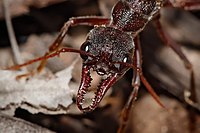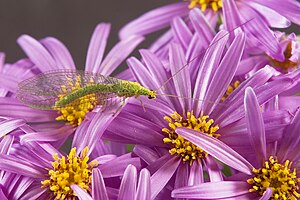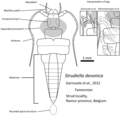Portal:Insects
The Insects Portal


Insects (from Latin insectum) are hexapod invertebrates of the class Insecta. They are the largest group within the arthropod phylum. Insects have a chitinous exoskeleton, a three-part body (head, thorax and abdomen), three pairs of jointed legs, compound eyes, and a pair of antennae. Insects are the most diverse group of animals, with more than a million described species; they represent more than half of all animal species. (Full article...)
Selected article -

The external morphology of Lepidoptera is the physiological structure of the bodies of insects belonging to the order Lepidoptera, also known as butterflies and moths. Lepidoptera are distinguished from other orders by the presence of scales on the external parts of the body and appendages, especially the wings. Butterflies and moths vary in size from microlepidoptera only a few millimetres long, to a wingspan of many inches such as the Atlas moth. Comprising over 160,000 described species, the Lepidoptera possess variations of the basic body structure which has evolved to gain advantages in adaptation and distribution.
Lepidopterans undergo complete metamorphosis, going through a four-stage life cycle: egg, larva or caterpillar, pupa or chrysalis, and imago (plural: imagines) / adult. The larvae – caterpillars – have a toughened (sclerotised) head capsule, chewing mouthparts, and a soft body, that may have hair-like or other projections, three pairs of true legs, and up to five pairs of prolegs. Most caterpillars are herbivores, but a few are carnivores (some eat ants, aphids, or other caterpillars) or detritivores. Larvae are the feeding and growing stages and periodically undergo hormone-induced ecdysis, developing further with each instar, until they undergo the final larval–pupal moult. The larvae of many lepidopteran species will either make a spun casing of silk called a cocoon and pupate inside it, or will pupate in a cell under the ground. In many butterflies, the pupa is suspended from a cremaster and is called a chrysalis. (Full article...)Did you know -
- ... that the fossil butterfly Prodryas persephone is so well preserved that individual wing scales can be seen?
- ... that the beetle Lixus concavus lives inside sunflowers?
- ... that the Niagara Parks Butterfly Conservatory imports up to 3,000 butterflies a month from around the world?
- ... that the extinct sawfly Pseudosiobla cambelli is one of three species of Pseudosiobla known from the fossil record?
- ... that members of Senostoma kill their hosts when ready to emerge?
List articles
Related portals
General images -
Selected image -

Green lacewings (Neuroptera: Chrysopidae) is a family of lacewings containing about 85 genera and (according to different sources) 1,300–2,000 species. Members of the genera Chrysopa (pictured) and Chrysoperla are very common in North America and Europe; they are very similar and many of their species have been moved from one genus to the other times and again.
WikiProjects

Main WikiProject:
Related projects:
- WikiProject Arthropods
- WikiProject Spiders
- WikiProject Animals
- WikiProject Tree of Life
- WikiProject Biology
Daughter projects:
Tasks
 |
Here are some tasks awaiting attention:
|
Associated Wikimedia
The following Wikimedia Foundation sister projects provide more on this subject:
-
Commons
Free media repository -
Wikibooks
Free textbooks and manuals -
Wikidata
Free knowledge base -
Wikinews
Free-content news -
Wikiquote
Collection of quotations -
Wikisource
Free-content library -
Wikiversity
Free learning tools -
Wiktionary
Dictionary and thesaurus



















































